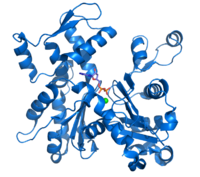
Photo from wikipedia
Type VI secretion systems (T6SS) plays a crucial role in Vibrio cholerae mediated pathogenicity. Tip of T6SS is homologous to gp27/gp5 complex or tail spike of T4 bacteriophage. VgrG-1 of… Click to show full abstract
Type VI secretion systems (T6SS) plays a crucial role in Vibrio cholerae mediated pathogenicity. Tip of T6SS is homologous to gp27/gp5 complex or tail spike of T4 bacteriophage. VgrG-1 of V. cholerae T6SS is unusual among other VgrG because its effector domain is trans-located into the cytosol of eukaryotic cells with an additional actin cross-linking domain (ACD) at its C terminal end. ACD of VgrG-1 (VgrG-1-ACD) causes T6SS dependent host cell cytotoxicity through actin cytoskeleton disruption to prevent bacterial engulfment by macrophages. ACD mediated actin cross-linking promotes survival of the bacteria in the small intestine of humans, along with other virulence factors; establishes successful infection with the onset of diarrhoea in humans. Our studies demonstrated VgrG-1-ACD can bind to actin besides actin cross-linking activity. Computational analysis of ACD revealed the presence of actin binding motif (ABM). Mutations in ABM lead to loss of actin binding in vitro. VgrG-1-ACD having the mutated ABM cannot cross-link actin efficiently in vitro and manifests less actin cytoskeleton disruption when transfected in HeLa cells.
Journal Title: International journal of biological macromolecules
Year Published: 2019
Link to full text (if available)
Share on Social Media: Sign Up to like & get
recommendations!